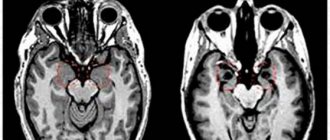Causes
Paranoid personality disorder occurs equally in men and women. It can manifest itself in a person whose relatives include people with schizophrenia or who had communication limitations in childhood (living in a family of emigrants, the deaf, under a strict totalitarian regime, etc.). There is no information on how widespread this disease is in the world.
There are several reasons contributing to the development of paranoid psychopathy:
- Evolutionary theory. According to her followers, suspicion helps to survive in any era. Focusing on the assertion that only the strongest will survive divides the world strictly into friends/foes, black/white - this becomes the foundation of paranoia.
- Hereditary theory - the disease is transmitted by genes from generation to generation.
- Psychoanalytic theory. If an individual grew up in a family where he was overprotected, physically punished for any offense, humiliated, and a lot was demanded of him, then he is at risk.
Interpersonal relationships with paranoia
A child who grows up paranoid suffers from feelings of his own reality. He was subjected to periodic suppression and humiliation. The family can convey to the child that they are the only ones who can be trusted. This creates suspicion in the child towards other people.
Borderline or neurotic paranoid individuals come from a family system where criticism and ridicule predominate. The child may be a scapegoat.
Uncontrollable anxiety can trigger the development of paranoia in children. When a child came to such a parent with a problem, he either presented this situation as catastrophic, since he could not bear the child’s anxiety, or devalued it, since he could not condense it. Such an adult conveyed to the child that thoughts are equivalent to actions. And the child perceived that his personal feelings had dangerous power.
As children, paranoid individuals did not have the opportunity to express their feelings naturally and safely. In a psychologist’s office with such clients, a specialist teaches paranoid individuals to do this.
We can also say that paranoid individuals are capable of deep attachment and relationships.
Paranoid personality
People suffering from paranoid personality disorder do not understand jokes at all - they have no sense of humor. They are unable to experience any failures; they are overwhelmed with negative emotions for any reason. These individuals are suspicious of favorable relationships, which is why they are unable to create normal, friendly relationships. At the same time, such a person is quite active and cannot sit in one place for a long time.
Psychiatrist Pyotr Borisovich Gannushkin, describing his patients, argued that paranoid individuals think monotonously, illogically, “twisting” everything in their own way. They do not accept criticism due to their high self-esteem. Paranoid people react to it with sharp physical aggression, abuse, and harbor anger and resentment for a long time.
Colleagues, relatives and friends of the paranoid suffer from his negativism. It is very difficult to be intimate or married to such a person, since he is constantly oppressed by pathological suspicion and the ensuing jealousy.
Paranoid people have the following characteristics:
- negative emotionality;
- hypervigilance;
- infantilism;
- they see the negative sides in everything;
- one-sided thinking;
- high self-esteem;
- conflict;
- aggressiveness;
- increased activity;
- pedantry.
P.B. Gannushkin identified the formation of overvalued ideas as the basis of paranoid personality disorder, and the most common of them is the patient’s conviction of his own hypersignificance. The individual thinks only about this, is unable to switch to something else, cannot control his own thoughts when they “rule” his mind. Based on this, the scientist proposed to classify paranoids according to the prevailing overvalued ideas: fanatic, litigious (slander, querulant), inventor, etc.
People with paranoid personality disorder neglect their health. Having received a diagnosis of any physical illness, they do not take any measures to recover: they refuse to take prescribed medications and follow the doctor’s recommendations. This affects their idea of someone’s bad attitude towards their personality.
There is also a classification of paranoid individuals according to the type of nervous system (according to Ernst Kretschmer, a German psychologist and psychiatrist):
- A sensitive paranoid is an unhappy person, a victim (as he himself believes). Those around him, in his opinion, treat him with malice, unfairly, and feel that he is an enemy. He is unsure of his abilities, closed, vulnerable, has low self-esteem, experiences failures greatly, is critical, but from time to time a sense of self-esteem flares up in him. A person suffering from this type of psychopathy accumulates negative emotions that can suddenly burst out through inappropriate actions: self-mutilation and beating others.
- An expansive paranoid is a very self-confident leader, and considers those who disagree with him to be dangerous. Suspicious, excitable, assertive, aggressive. He is quite pleased with himself, considers himself exceptional, ideal, perfection, does not recognize indications of shortcomings, considers himself the best in a certain matter and builds a successful career only so that others envy and admire him. Such a person can be called “two-core” - he almost never gets tired, is active at any moment, and his mood is always elevated.
Story
In general, paranoia has been the object of close attention of representatives of the psychodynamic approach from Freud to the present day. A typical view of this disorder is presented by Shapiro (1965, pp. 54-107). After a detailed discussion of the paranoid cognitive style, he argues that the disorder is the result of the “projection” of unacceptable feelings and impulses onto other people. Theoretically, attributing inappropriate urges to others reduces or eliminates blame for those urges and thus serves as a defense against internal conflict. The view of psychoanalysis is essentially that a person missees in others what is factually true for himself, and as a result experiences less suffering than if he took a more realistic view of himself and others.
A cognitive-behavioral model of paranoia similar to this traditional view was presented by Colby and his colleagues (Colby, 1981; Colby, Faught, & Parkinson, 1979). These researchers developed a method of computer modeling the responses of a paranoid client in a psychiatric interview that is so realistic that experienced interviewers are unable to detect the difference between the responses of the computer and the paranoid client if the interview is sufficiently limited (Kochen, 1981). Colby's model is based on the assumption that paranoia is actually a set of strategies aimed at minimizing or preventing shame and humiliation. It is assumed that a paranoid person has a strong belief that he is inadequate, imperfect, and flawed. This is believed to lead to the experience of intolerable shame and humiliation in situations where the person is the object of ridicule, falsely accused, or suffers from a physical disability.
Colby hypothesizes that when there is an “abusive” situation, a person may avoid taking the blame and the resulting feelings of shame and humiliation by blaming someone else for what happened and claiming that they were treated unfairly. The anger and/or anxiety that results from attributing problems to persecution by ill-wishers is assumed to be more acceptable than the shame and humiliation that arises when a person is held accountable for what happens. Colby (1981) also notes that a paranoid person's attributions have a major impact on interpersonal interactions. If a paranoid person takes action against people to whom they attribute bad intentions, they may take retaliatory measures that include actions that are potentially offensive. Thus, in reality, paranoid behavior may indirectly increase the shame and humiliation that it was intended to reduce. Although Colby's model is interesting, it should be noted that his computer program simulates a patient who is delusional and thus does not meet the diagnosis of BPD.
Actually, BPD has been the object of attention of many authors. Cameron (1963,1974) views this disorder as arising from a lack of trust that results from parental abuse and lack of parental love. The child begins to expect sadistic treatment from others, be vigilant to signs of danger, and act quickly to protect himself. A person's alertness leads to the fact that he detects subtle signs of negative reactions of other people, then reacts intensely to them and at the same time is poorly aware of the impact of his own hostile attitudes on others.
Millon (1981) argues that BPD almost always co-occurs with other personality disorders and discusses each of the five major subtypes separately. The "paranoid-narcissistic" subtype is seen as developing as a result of a strong belief in self-worth coupled with a lack of social skills. Millon hypothesizes that when these people are faced with an environment that does not share their beliefs in their worth, they will indulge in fantasies of their own omnipotence rather than admit their shortcomings. The “paranoid-antisocial” personality is seen as developing as a result of parental persecution and hostility, which led to a perception of a harsh world and to rebellious, hostile behavior that provoked rejection from others. “Paranoid-compulsive” people are seen as having learned to strive to completely obey rigid parental rules and, as a result, remain overly controlling, perfectionistic, withdrawn, and self-critical. Paranoia occurs when the hostility inherent in their harsh self-criticism is attributed to others. Millon hypothesizes that constitutional factors contribute to the development of the "paranoid-passive-aggressive" personality, provided that the infant's responses to the parents elicit conflicting parental responses. Subsequently, they lead to the fact that the child grows up to be an irritable, negative person who is unable to maintain stable relationships. This leads to social isolation and the development of delusions of jealousy. Finally, the “decompensated paranoid” personality is seen as one predisposed to developing psychotic episodes in response to stress and possibly being a link between BPD and psychosis. Millon (1981) does not provide a general theoretical model of BPD or discuss possible interventions.
Turkat (1985, 1986, 1987; Turkat & Maisto, 1985) recently presented a cognitive-behavioral model of the development and maintenance of BPD that is based on detailed case studies. According to Turkat, early interactions with parents teach the child: “You should be wary of making mistakes” and “You are different from others.” It is hypothesized that these two beliefs result in a person who is highly concerned about the evaluations of others, but also has to live up to parental expectations that prevent him from being accepted by his peers. This ultimately results in such a person being ostracized and humiliated by his peers, but lacking the interpersonal skills needed to overcome the ostracism. Consequently, the person spends a lot of time thinking about his loneliness and mistreatment by his peers and eventually comes to the conclusion that the reason for the persecution is because he is special and others are jealous of him. This “rational” explanation is supposed to alleviate the suffering that results from social exclusion. It is proved that the resulting paranoid idea of others strengthens a person’s isolation, which is due to two reasons. First, a person's anticipation of rejection causes social interactions to generate significant anxiety. Second, acceptance by others will threaten this explanatory system.
Symptoms
As mentioned, paranoid personality disorder begins to manifest itself in childhood. Its first signs: straightforwardness, stereotypical thinking, distrust. The child often gets into a showdown with peers, gets offended, remembers the insults and tries to take revenge for them. He is not interested in the feelings and needs of other people.
After 20 years of life, it becomes difficult for a paranoid person to adapt to changes; he begins to see life exclusively in black and white, and to think the same way. It seems to him that people around him are hostile and want to appropriate his achievements and property. He is “gnawed” by doubts about the loyalty of his friends and partner, jealousy. The patient considers every word and deed of those around him to be filled with hidden meaning that is harmful to him. For example: children in the apartment upstairs stomp loudly, because their parents taught them this specifically to annoy the neighbor below.
The person suffering from paranoid disorder is sensitive to insult and harm, even if an apology has been made for it. With his help, even the smallest offense grows into a big conflict and irreconcilable enmity.
If a paranoid person is treated with disrespect or seems to be disrespectful, then an instant “response” will follow in the form of an outburst of anger or a counterattack. Suspicion does not allow such a person to share intentions or feelings with those close to him, so that no one can use the information received against him.
Paranoid people suspect others of various terrible offenses, interpreting their behavior using their imagination. They can even construct a completely logical confirmation of their statements, convincing the listener of the indisputability of the facts they have invented.
Emotions in patients are strong, but one-sided: dissatisfaction, disappointment, anger, and irritability prevail. Responsiveness, warmth and sense of humor are alien to them. They love only themselves; possession of power and strength deserve their admiration, and weakness deserves contempt.
A hypervalued obsession is formed (this was discussed above). It becomes a goal, and its objectivity or subjectivity is completely unimportant, although it may be completely absurd - in the opinion of the paranoid, this is socially important. That is, a person is ready to fight to the end for the public good in his personal opinion, showing a kind of messianism. When achieving a goal, he only needs recognition of merit, and not joy for bringing any benefit to society. The main thing is to be called irreplaceable and very necessary.
Paranoid individuals work diligently, but only if their work activity coincides with a super idea. They do not accept any criticism, since they consider themselves experts and great specialists in a certain topic. Compromise with colleagues of equal or lower rank is excluded, although minor concessions to superiors are possible.
The people around him, even his close ones, in the patient’s opinion, should contribute in every possible way to achieving his goal; for his own benefit, he often uses lies and manipulation.
There have been many people in history with characteristic paranoid signs: Lenin, Peter the Great, Thomas Edison, Bobby Fischer.
So, we list the main signs of paranoid psychosis:
- provoking conflict;
- idealization of oneself;
- inadequate perception of criticism;
- self-isolation;
- dissatisfaction with everyone and everything;
- an obsessive desire to fight for your rights anywhere;
- taking mistakes and failures to heart;
- pathological jealousy, distrust;
- looking for negativity in the words and deeds of other people;
- the desire to focus everything on oneself;
- exaggeration of one's own importance.
Disharmonious, conflicting traits of the Paranoid personality type
A disharmonious conflict feature is the uncertainty of which side they are on in a conflict situation. That is, until the very end it is not clear whose side the Paranoid One supports, because in fact, he always supports his own interests. The main theme is not to let yourself down.
They find it very difficult to say “no” to others. Moreover, this is a certain unambiguity, so Paranoid people tend to schedule several meetings for the same time, on the same date, in different parts of the city, or better yet, continents. And it is never completely known which of them they will come to, because more often than not they will not go to any. Paranoid people constantly strive for unpredictability: “you won’t figure me out, you won’t count me out, I have a hard time counting myself out!”
They are very afraid of being predictable, and in this they are predictable.
What is also characteristic of the Paranoid is disgust , which manifests itself literally at the entire everyday level. For example, if you take their cup and take a sip, the paranoid person will not finish it. Disgust is here a form of protection from danger, which results in the overvalued idea of “impact”, “infection”, etc.
Disgust = Safety
Just as in the case of facts, it is the idea that is primary here, and the whole life is already built around it. For example, “order on the table” or “cleanliness” is perceived differently by the Paranoid, depending on what is included in their idea of “security.” And here they can be even more compulsive.
A compulsive personality type will do the cleaning or put order on the table according to the rules, as it should be “for people”, and nothing more. A paranoid woman can do deep cleaning every two days, and such that not a single germ will survive.
Because Paranoids pay constant attention to their own personal boundaries, they are focused on constantly protecting themselves from invasion, even when no one is encroaching on their territory.
Other conflicting traits of the Paranoid:
- Hypercontrol (of loved ones and yourself, your desires)
- Difficulties in expressing and understanding one’s own experiences (with a ban on their expression and implementation). They hold back their emotions.
- Punishing oneself for realizing one’s ideas-desires (for example, they often make unfulfilled promises, for which they are scolded), as a result, ideas-desires are realized in a “crooked way.”
- It is difficult to say “no”, to refuse (it is better to make an unfulfillable promise and “run away”).
- The desire to look for a hidden meaning, a secret conspiracy, a threat in everything.
- “Selectedness”, unusualness (people are “nasty microbes”, aversion to them, disgust).
Therapy
The diagnosis of “paranoid personality disorder” is made on the basis of characteristics characteristic of this disease that are observed in the patient throughout his life. The psychiatrist should exclude the presence of delusional disorder, paranoid schizophrenia, consequences of organic brain pathology, skull injuries, drug addiction and alcoholism.
To treat the disorder, medications and psychotherapy are used in combination. Sedatives, tranquilizers, and antipsychotics are prescribed as medications. However, since this is negatively perceived by the patient due to his suspicion (refusal to take it, complaints about ineffectiveness), the courses are usually prescribed very short.
To conduct successful psychotherapy, a specialist needs to establish a trusting, frank relationship with the patient in order to choose the appropriate technique. This can be behavioral psychotherapy, psychoanalytic or Jungian depth psychoanalytic therapy.
Such treatment lasts quite a long time, since the patient’s negativistic life position does not allow him to interact normally with the doctor. Therefore, the latter needs a lot of experience and patience. The paranoid person is aggressive towards the specialist, splashes out negative emotions on him, but this must be endured and everything possible must be done so that the patient realizes and overestimates the conflict artificially caused by him, extinguishes the aggression and gets rid of the overly valuable idea.
We are also working with relatives. They should be taught to turn the upcoming conflict into a humorous side, to make sure that there is as much positivity in the patient’s life as possible, and to avoid critical remarks towards the patient.
Unfortunately, paranoid disorder cannot be completely cured. With age, its symptoms become stronger, but if therapy is started on time and it is adequate and professional, then it is quite possible to achieve stable remission.
Diagnostic criteria
The diagnosis is made based on the presence of a certain clinical picture of the disease in the patient. The doctor also looks at the characteristic signs of disharmony in the actions and personal characteristics of the patient, affecting all components of his life.
These include deviations of an emotional nature, thinking, lack of control over one’s own actions, incorrect behavior towards others, etc.
Also, when conducting diagnostics, doctors differentiate paranoid disorder from paranoid schizophrenia, delusional disorder, as well as psychopathic disorders caused by the use of alcohol, narcotic and other psychotropic substances.
What are the main ways to treat paranoia and how should others behave during an attack of paranoia?
Paranoia is a psychiatric illness that is very difficult to treat. This is explained by the fact that, due to his supernatural suspicion, the patient does not trust anyone or anything, spreading his suspicions to the doctor and the drugs he prescribes. He perceives psychotherapy as another attempt to manipulate his consciousness. In addition, the paranoid person categorically denies the painfulness of his condition, and loved ones who prove the need for treatment are transferred by the paranoid person to the category of “enemies.” The need for treatment becomes especially acute if a person ceases to be socialized, which is manifested by a readiness to isolate himself from the “persecuting” society or even to attack an object that he believes is harmful. This transition from the passive course of the disease to the active phase is an indication for inpatient treatment. In case of an attack of paranoia, it is necessary to call an ambulance, and unnoticed by the patient. Before the arrival of a specialized team, do not contradict the patient under any circumstances, accept his position and even play along slightly. Don't try to prove anything or appeal to common sense. This is useless and even dangerous, since the delusions of a paranoid cannot be corrected. If the arriving specialists cannot stop the attack and relieve psycho-emotional stress on the spot, the patient is hospitalized. In case of chronic paranoia, outpatient complex treatment is indicated, the main element of which is drug therapy with the use of anti-delusional antipsychotics. Their action is aimed at normalizing the exchange of neurotransmitters and blocking the excitation of nerve centers responsible for the symptoms of paranoia. The prescription of other pharmacological drugs is symptomatic in nature and is aimed at eliminating the symptoms of paranoia that prevail in a particular patient. For example, antidepressants are used to relieve depressive moods, tranquilizers to eliminate fear and anxiety, and sleeping pills to normalize sleep. An additional and important area of comprehensive treatment of paranoia is psychotherapy. It is aimed primarily at restoring socialization and eliminating elements of irrational behavior in patients with paranoia.
At the first stage of treatment, the main thing is to establish contact and trusting relationships with the patient. This is extremely difficult to achieve, but it is possible. If the patient himself has decided to undergo treatment and correctly assesses his condition, this is already half the success in getting rid of paranoia. Unfortunately, such a development of the situation is rarely observed. Most of these patients remain outside the attention of psychiatrists and psychotherapists (what is the difference between a psychiatrist and a psychotherapist) for a long time, sometimes for decades. If, during an exacerbation, situations arise that are life-threatening to the patient himself (auto-aggression) and/or his environment, then only then does treatment begin, usually in an inpatient setting. The choice of drugs, as well as psychotherapeutic methods of correction, depends on many factors - on the general physical condition of the body, mental characteristics, gender, age and basic symptoms.
When taking medication, it should be borne in mind that abruptly stopping medication can lead to the so-called withdrawal syndrome, when, after stopping treatment, the symptoms of the disease return again and sometimes with greater force than before treatment.
Only drug therapy, not supported by psychotherapy, is not capable of completely returning the patient to normal life in society. It is possible to achieve stable and long-term remission only with the use of both methods of therapy - medication and psychotherapy. The most effective treatments for paranoia include Gestalt therapy, cognitive behavioral therapy (CBT) and psychodynamic psychotherapy. Unfortunately, paranoia is a disease that takes a long time and is difficult to treat, sometimes for 10 years. If treatment is carried out on an outpatient basis, then it is important to take medications according to the regimen developed by the doctor, regular psychotherapy sessions, follow the recommendations of the psychotherapist, use the acquired communication skills, and after achieving remission, periodic consultations with the specialist supervising the patient.
Types of paranoid psychopathy
Experts distinguish two opposing types of paranoia: expansive (strong) and sensitive (weak).
Expansive paranoids are, as a rule, conflicting individuals prone to pathological jealousy and truth-seeking. Already from childhood they are marked by deceit and vindictiveness. Very often they point out the shortcomings of other people, but they do not notice them in themselves. Such people generally always have a favorable attitude towards their own personality, and even failures do not unsettle them.
It is very difficult for paranoids of this type to obey anyone, but they are always in a state of struggle with personal opponents. They are not at all worried about the common cause. Such people have an increased rate of mental activity, energy, fussiness, and mobility. Often this person does not even need rest, he is always cheerful.
Separately, experts identify fanatics , who also belong to expansive paranoid individuals. These patients show exceptional passion, completely devoting themselves to one activity. Almost their entire life is subordinated to one specific idea. Often their obsession is so strong that they can attract other people to their object of worship. Fanatics blindly believe in what they have subordinated their lives to and do not require proof. However, unlike patients with other types of paranoid disorders, fanatics do not put their own personality forward. At the same time, they still do not show love and compassion for their neighbors and are often cruel.
With the sensitive version of paranoia, a person combines opposite traits. On the one hand, psychopathy consists of a combination of contrasting personality traits. On the one hand, the patient shows shyness and looks vulnerable. On the other hand, he is ambitious and has an inflated sense of self-worth. Such patients are fearful and shy, but at the same time especially suspicious and irritable. They subject themselves to self-torture, constant self-analysis, which negatively affects the quality of their life. As a rule, a person has established standards that he has not reached, and this provokes a heightened sense of failure.
Features of communication with a patient with paranoia
If a loved one has a paranoid disorder, then an important point in the treatment process is the correct approach to communicating with him. Under no circumstances should the patient be allowed to drink alcohol. Monitoring by loved ones over compliance with all doctor’s recommendations and timely attendance at psychotherapy sessions is important.
It is important for those who live next to a paranoid person to expect that they will need a lot of patience. You cannot show aggression towards the patient or excessively express your emotions. You need to have a conversation with him, as with a healthy person, but do not laugh at him. The tone of the conversation should always be confident and calm. You cannot humiliate a patient. On the contrary, you should convince him that there is truth in his words, since attempts to convince a person are doomed to failure. But the most important thing is to contact a specialist in time who will help develop treatment tactics.











